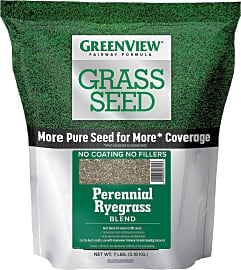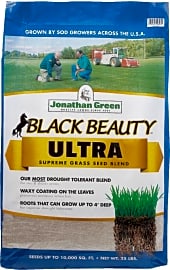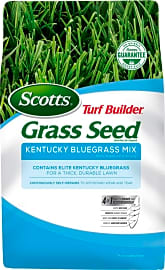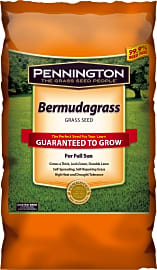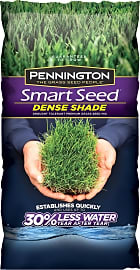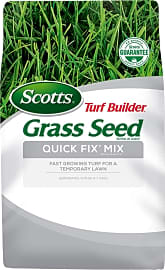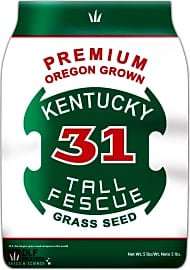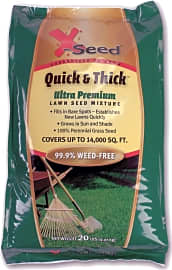The 10 Best Grass Seed

This wiki has been updated 42 times since it was first published in July of 2015. Whether you're trying to repair a bare or damaged spot in your garden or need to cover a larger area, such as a playing field or common space, you'll find what you need in our selection of grass seed. With different varieties suited to different climates and levels of sun exposure, these options produce hearty and durable blades that are good for everything from football fields to front lawns. When users buy our independently chosen editorial choices, we may earn commissions to help fund the Wiki.
Editor's Notes
October 20, 2020:
For this update, we've added the Scotts Quick Fix, which is designed for people who don't have much time to wait for their lawn to grow. The mix made our list because it's from a top brand, it's affordable, and it has great reviews. We've removed the Hancock Centipede because of availability issues with the manufacturer.
We've also updated the Kentucky 31 Tall Fescue, the GreenView Fairway Formula, and the Jonathan Green Black Beauty. Many of the seeds on our list have stayed there because they represent the highest-rated products from dependable companies like Scotts, Pennington, and GreenView. These three companies offer multiple varieties for different regions, and you generally can't go wrong with them as long as you choose the product that is suited to your climate and sun exposure.
April 16, 2019:
First of all, remember that growing grass, like any plant, is not magic. Different strains call for different planting times, soil conditions, and levels of treatment, so if you're going to invest time and money into seeding a lawn, make sure to take all the appropriate measure to give it the best chance of succeeding.
With that said, Scotts Turf Builder is one of the more popular brands, and their Sun and Shade mix is highly versatile and thrives in a wide range of climates. Their Kentucky Bluegrass is an excellent choice that feels great on bare feet, though its use is restricted mostly to Northern states. The Greenview Fairway blend consists of hardy perennial Ryegrass, and it grows quickly and can stand up to plenty of foot traffic.
If you're in a particularly dry area, Pennington's Bermudagrass is worth a look, as is Hancock's Centipede. While Centipede is awfully expensive compared to most, it's one of the most resilient strains of grass on the market. Kentucky 31's fescue is a single-strain bulk option that isn't the very softest, but is pretty easy to care for. Barenbrug's Water Saver and Pennington's Smart Seed are both bred for low-moisture areas, so homeowners in arid Western regions should consider either of those, based on the level of sun it'll be getting.
Jonathan Green's Black Beauty and X-Seed's Ultra Premium are both multi-strain blends that offer a good balance of softness and growing speed, plus, they're both relatively inexpensive, making them good options for large areas.
Popular Types Of Grass Seed
They tend to grow best in temperatures ranging from 75°F to 90°F and will often turn brown or go dormant in the cooler late-fall and winter months.
There is a wide range of grass varieties, but there are just two basic categories of grass types: Warm Season grasses and Cool Season grasses. As you might imagine, all of the different varieties in each of these grass types are best suited for a certain type of climate.
Warm Season grasses are generally native to tropical regions and thrive when they are in hot climates with a lot of daily sunshine. They tend to grow best in temperatures ranging from 75°F to 90°F and will often turn brown or go dormant in the cooler late-fall and winter months.
The majority of Warm Season grasses growing happens in the summer months. Some examples of popular Warm Season grass varieties include St. Augustine grass, Buffalo, Bermuda, and Centipede.
Cool Season grasses do well in areas that have cold, freezing winters and very hot summers. They grow the fastest when temperatures are from 65°F to 80°F, or during the spring and fall months.
While Cool Season grasses are suited to climates that have regular intervals of rain in the summer, many of them can withstand long periods of drought by going dormant. Some popular examples of Cool Season grasses include Perennial and Annual Ryegrass, Kentucky Bluegrass, Red Fescue, and Bentgrass.
Choosing The Best Grass Seed For Your Lawn
You can start your search for the best grass seed for your lawn by learning which type of climate you live in. If you are in the Warm Season zone, you should be researching the different varieties of those suitable grasses, and vice versa for the Cool Season zone.
Each grass variety has certain applications where it does best. For example, Bahia grass and Buffalo grass are both Warm Season grasses, but they have different characteristics. Bahia grass does best in full sun conditions and in areas with sandy, slightly acidic soil. It needs regular watering, but is relatively resistant to short periods of drought and is ideal for high activity areas.
You can start your search for the best grass seed for your lawn by learning which type of climate you live in.
Unfortunately, while being an extremely hardy grass, it doesn't create a very uniform lawn and it doesn't handle the cold very well. On the other hand, Buffalo grass has a smoother, more manicured look and can withstand near-freezing temperatures for short periods. It can also survive through extended drought periods but doesn't do well in high-activity areas.
To choose the best grass variety for your home, start by testing the pH of your soil. You can adjust your soil pH as needed, but why not choose a grass variety that does well in your soil type and skip the hassle? Next, you should consider how much maintenance you want to put into lawn care. If you don't want to deal with regular waterings, go with a drought-resistant variety.
If you don't want to have to mow so often, choose a slower-growing variety. You'll also want to consider how much traffic you'll be subjecting your lawn to. Some grass varieties can deal with cars being parked on them regularly, while others can't even withstand minor foot traffic.
Not everybody lives in a Cool Season or Warm Season grass climate. There is a narrow band across America known as the Transition Zone and picking the right grass variety in these areas can be trickier. If you live in the Transition Zone, you'll want to consider Kentucky Bluegrass, Zoysiagrass, Thermal Blue, Perennial Ryegrass, or Tall Fescue.
How To Plant Grass Seed
Creating the perfect lawn isn't just about picking the right variety. You'll also need to maintain it correctly and plant at the right time of year. A general rule of thumb is that Warm Season grasses should be planted from March through September, and Cool Season grasses should be planted from mid-August through mid-October, but refer to the directions on your specific grass variety to further narrow down the best seeding time.
Next, remove large debris and break up any big clumps of soil.
You need to make sure to prepare your lawn before laying down your seed as well. If you are planting a new lawn, start by loosening the top few inches of soil with a cultivator or hoe. Next, remove large debris and break up any big clumps of soil. If you have any low spots where water might collect, you should level them out, so no grass seed is left in standing water for too long.
After your lawn has been fully prepared, you can spread your grass seed. You should fertilize with a starter fertilizer after seeding, and then water twice a day, for the best results. Once you have mowed your new lawn one or two times, you can revert to a normal watering schedule.
If you are overseeding an existing lawn, you'll want to mow your grass as short as possible, loosen any bare soil spots, remove dead grass clumps, and then spread the seed as evenly as possible. As with a new lawn planting, you should water twice a day until after the first or second mowing and lay down a starter fertilizer.


